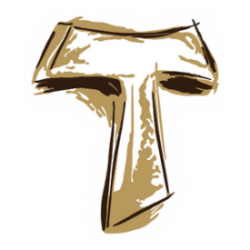Solanus Casey Center – Bus Tour – Ford’s Garage
By Michael Gath, OFS

For the day away during the National Chapter event, the Divine Mercy Region hosts treated fraternity members to a bus tour of the City of Detroit. We experienced the Solanus Casey Center, including the celebration of Mass at the St. Bonaventure Chapel connected to the center.
On the way, we crossed Detroit’s Gateway Bridge. This bridge was built in preparation for the 2007 Super Bowl XL, which was evident by the designers incorporating football-like ovals in its structure.
Next, riding along Interstate 96, we passed the biggest tire on the planet―the Uniroyal Giant Tire. It was produced by the United States Rubber Company in 1964 for the New York World’s Fair as a Ferris wheel. Not long after the fair ended, the giant tire was disassembled and shipped to Detroit.
Moving along, we were able to see something unique to Detroit, known to be the third most visited tourist site for city, the Heidelberg Project. This art project was designed around two city blocks to inspire people to use artistic expression to enhance their lives and communities. It is in a neighborhood that suffered deterioration after the 1967 Detroit riots.
 Once at the Solanus Casey Center, we entered through the Creation Garden. Intriguing pieces of art symbolized Sister Water, Moon, Earth, Brother Sun, Fire, Wind, and a four-thousand-year-old piece of dark wood depicting Sister Bodily Death.
Once at the Solanus Casey Center, we entered through the Creation Garden. Intriguing pieces of art symbolized Sister Water, Moon, Earth, Brother Sun, Fire, Wind, and a four-thousand-year-old piece of dark wood depicting Sister Bodily Death.
Entering the Solanus Casey Center, we were greeted by many seculars from Divine Mercy Region. Sally McCuen, OFS, a co-author of a self-guided prayer booklet about the Center, gave the opening presentation.
Bernard Casey (a.k.a Blessed Solanus Casey) was born and grew up in Prescott, WI. He took on many jobs before considering religious life. AWer working as a logger, prison guard, and streetcar operator, his life changed when he witnessed a murder. In prayer, he heard the words “Go to Detroit,” which he did. He headed to St. Bonaventure Monastery.
In the seminary, he was given the name Solanus as a Capuchin simplex priest. God would grant many with blessings of healing and answered prayers through Blessed Solanus Casey’s intercession for them. The uniqueness of Solanus was that he was sought by everyone. All denominations of faith, and even atheists, would seek him out for help with their intentions. He was known to have a deep desire for the conversion and unity of the world.
During the guided tour, our first exhibit was the Beatitudes of Christ. Here we encountered life-sized bronze statues of those who exemplified the
beatitudes. They included Blessed Mother Theresa, Martin Luther King Jr., and Archbishop Oscar Romero.
We entered the museum section dedicated to Blessed Solanus Casey’s personal artifacts. Immediately on entry, we were able to see what a big family Solanus came from through life size displays of photographs that must have been taken shortly after he entered the order.
On exhibit were items such as his habit, violin, sandals, prayer book, and rosary. Also within this section of the museum is a replica of his humble bedroom. Winding through toward the end of the exhibit, the center has Blessed Solanus Casey’s desk on display.
Moving on, we finally approached the tomb of Blessed Solanus Casey, located at the entrance to St. Bonaventure Chapel. The public can pray next to the exposed crypt containing his coffin, which is covered by glass.
We attended Mass in the St. Bonaventure Monastery Chapel. Beautifully designed, it includes a magnificent painting by Wilhelm Lamprecht of St. Francis receiving the stigmata. It was restored and shipped from St. Francis of Assisi Church in Milwaukee, where Blessed Solanus Casey was ordained. Directly in the rear of the Chapel is a relic of Blessed Solanus Casey.
Before Mass, we heard the testimony of a friar whose family was related to the Caseys. He explained how his brother was involved in a serious accident and was likely to lose his leg. After meeting with Blessed Solanus and asking for prayers, he told them everything would be all right. On the day of surgery, the doctors determined that the boy would not require the surgery. A healing had been granted.
Concluding our visit and celebration of Mass at the Solanus Casey Center and St. Bonaventure Chapel, we boarded the bus for the second part of the Detroit tour. We went to Belle Isle, and as our friendly bus driver, Earnest, kindly pointed out, it was at one time known as Hog Island. At one point the island was infested with snakes. To combat this, a herd of pigs was released on the island. It must have worked, because now the Belle Isle is a beautiful park that hosts a conservatory, nature center, and giant slide.
From Belle Isle, we headed to downtown Detroit. The bus ride through downtown gave us good views of some of Detroit’s well-known landmarks, including:
- The Spirit of Detroit – A downtown monument displaying a large figure holding a sphere with rays symbolizing God in one hand and family in the
- The Renaissance Center – A group of seven connected skyscrapers and headquarters of General
- The Kern’s Clock – A historic clock that once adorned the Ernst Kern Company department store
- Detroit Professional Sports Venues – Comerica Park, Ford Field, Little Caesar’s Arena
After leaving downtown Detroit, we headed to Ford’s Garage restaurant. We had great fellowship and a good meal to cap the day’s tour. Ford’s Garage gives the sense of being an old-time service station back in the 1920s. On display were vintage Ford automobiles and gas pumps from the early days.
Thanks to the Divine Mercy Region hosts for a fantastic pilgrimage/tour of the gems of the Motor City.
Blessed Solanus Casey
by Donna Hollis, OFS
Sometimes we look at Saints whose actions appear to be beyond our capabilities. Blessed Solanus Casey’s actions are very much within reach as he focused on the relationships with those he encountered.
At the Chapter, the life of Blessed Solanus Casey was portrayed in a most creative way with storytelling, video, music, and song, with audience participation in the play “More Love than Skill: A Saint and His Fiddle” by Br. Al Mascia, OFM.
The ambience of the play touched the heart strings of those of us who attended. The story of Blessed Solanus Casey came alive with the personal touches that the actor shared with enthusiasm. The songs were like chants that gave us time to reflect on who this blessed man was and how he lived by reaching out to the marginalized in our society.
Blessed Solanus embodied the prayer attributed to St. Teresa of Ávila, “Christ has no body now but yours, no hands, no feet but yours. We are the compassion that looks out to the world…”
I left with a sense of what was in Blessed Solanus’s heart and with respect for his ministry to those in need. He was a man of God who changed people’s hearts and lives. We, in turn, can mirror his heart by reaching out with compassion to those most in need.
If you would like to learn more about Br. Al Mascia, OFM, and his ministry, visit: http://brotheral.org/



Leave A Comment